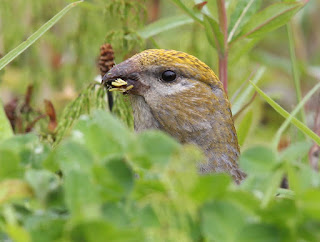June 23 is a late date for a spring overshoot Glossy Ibis in Newfoundland. But there was one (maybe two) in the St. John's area today. The first sighting of a Glossy Ibis was in the morning at Lundrigans Marsh at the eastern end of St. John's. Then in late afternoon news surfaced of a Glossy Ibis at the unlikely location of the Ruby Line Duck Pond in The Goulds (<ten minutes as the ibis flies). We don't know exactly when this bird appeared so can not be sure if there were two Glossy Ibis today or one. Or if there is a connection with the two Glossy Ibis at Third Pond in the Goulds for one day only on 25 May?
The Goulds bird today was feeding ravenously and was exploring some wet places that seemed marginal for a Glossy Ibis. It was acting like it was a new bird on the block having just arrived in Newfoundland or the area at least. Maybe some other southern vagrants will surface in the next day or two that would support the idea of a fresh arrival from the south. Today we experienced the remnants of named tropical storm Bill. But that was such a low key slow mover it seems unlikely to be the force behind Glossy Ibis in eastern Newfoundland.
The Glossy Ibis at the Ruby Line Duck Pond, Goulds, Avalon Peninsula, Newfoundland - 23 June 2015.
Who knows how much it was finding to eat. It hardly stopped probing deep into the mud and water long enough for a breath.
It was a bad hair day at times.
Who is the ugly duckling here?
This is a photo of a White-faced Ibis from southern Alberta in June 2009 where it is a locally common nester. The wide white border around the red lores (not gray) and the pink legs (not gray) and red eye (not dark) tell the story. White-faced Ibis has been expanding eastward in leaps and bounds and is likely to happen in Newfoundland in the near future.


























